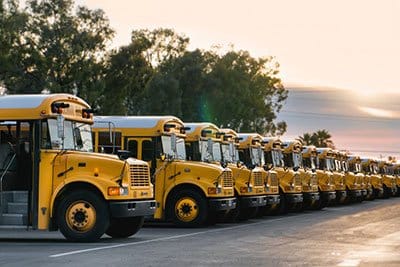When it comes to the safety of our children, nothing takes a backseat. However, with the advent of technology and modern standards for road safety, it is becoming increasingly important to stay informed about school bus safety regulations.
This blog post will explore one such regulation: Would seatbelt laws make school buses safer? We'll examine both sides of this argument while highlighting key points from each side and providing references that support either perspective.
Additionally, we provide an up-to-date guide on current state-level policies regarding seat belts on school buses and potential laws or policy changes being considered by some states in 2023.
More...
Take Away Key Points:
Seat belts on school buses: yes or no?

School bus seat belts are a highly contested safety measure, with some people in favor of them and others completely against them.
On the one hand, it makes sense that a seat belt would be an effective way to keep students safe while in transit, as they could help prevent serious injury in the event of an accident.
However, many also object to this idea, citing additional costs for busing companies and complicated strapping systems that can often make it difficult or impossible for specific individuals with special needs to use them properly.
"Seat belts play an important role in keeping vehicle passengers safe, but since school buses are different by design, they have a different kind of safety restraint system.", according to the NHTSA.
According to the National Highway Traffic Safety Administration (NHTSA), the weight and crash dynamics of large school buses are different from those of passenger cars and light trucks, which results in less crash force experienced by bus passengers.
To provide crash protection to these passengers, NHTSA has introduced a concept called "compartmentalization". This means that the interior design of large buses protects children without requiring them to wear seat belts. In addition, the seats are designed to be strong and closely spaced with energy-absorbing seat backs, which helps protect children from crashes.
Astonishingly, a study conducted by the Bartholomew Consolidated School Corporation revealed that students riding school buses with seatbelts were substantially less likely to misbehave than those sitting without them.
Ultimately, the decision over whether or not to include school bus seat belts falls into the hands of local officials, who must consider both cost and safety when making their determinations.
Would wearing seat belts on school buses make a difference?
Wearing seat belts on school buses could make a difference in safety, as they provide an additional layer of protection for students in school bus accidents.
However, it is important to note that there are other factors to consider, such as the design and construction of the school bus itself. As previously mentioned, NHTSA's concept of "compartmentalization", which includes closely spaced seats, is effective in protecting students during crashes.
Ultimately, any decision regarding seat belt use on school buses should prioritize the safety and well-being of the students.
Why do most school buses lack a seat belt?
There are several reasons why most school buses lack seat belts. One of the main reasons is that most school buses are designed with safety features that protect passengers without the need for seat belts.
Additionally, school buses are built with high, padded seats with energy-absorbing backs, which help protect passengers in a crash.
Another reason why school buses typically do not have seat belts is due to the cost and logistics involved in installing them.
Many school districts believe that retrofitting older buses with seat belts can be expensive and may require modifications to the bus structure itself. Furthermore, enforcing seat belt use among children may prove difficult for drivers and could potentially lead to other safety concerns while on board.
Furthermore, students may use safety belts as weapons to hurt each other. They also do not keep their seatbelts fastened on school buses which can be dangerous in an emergency; they could fail to escape efficiently without alerting the bus driver. All these put them at significant risk and should be avoided by ensuring that all students are securely buckled up while aboard the bus.
Overall, while seat belts can provide an additional layer of protection, there are many factors to consider before deciding whether or not they should be implemented on school buses.

States that have a mandatory school bus seat belt
Only eight states in the United States have laws requiring seat belts laws on school buses: California, Florida, Louisiana, Nevada, New Jersey, New York, Texas, and Arkansas.
Recently, Indiana adopted a suggestion that urges the legislative council to consider the seating compartment and the state laws along with state legislatures to study the topic of seat belts on school buses.
The specific requirements and exceptions for seat belt use on school buses vary by state. While some states have enacted laws requiring them, others have not yet taken action. For example, in Florida, it is mandatory for school buses purchased after January 2001, and school buses manufactured in that period to be equipped with three-point seat belts and lap belts that would ensure the safety of school bus passengers.
Moreover, the implementation of seat belt laws in Arkansas, Texas, and Louisiana are subject to approval from local jurisdictions. In New York, individual school boards determine whether the students will wear safety belts on school buses.
Weight requirements determine the necessary safety equipment on buses, and since small school buses weigh 10,000 pounds, no shoulder belts are mandated. Unsurprisingly though, installing lap belts and shoulder seat belt systems/three-point seat belts onto each bus is estimated to cost between $7000 - $10,300 per vehicle according to the National Transportation Safety Board; yet this small price could be worth it for preventing needless injuries, by introducing seat belt laws in school buses.
Texas laws require that school districts equip their new buses with three-point seat belts/ lap and shoulder belts - something only Texas, California, and Florida require on school buses. Three-point seatbelts provide the same security level as in cars.
New Jersey mandates that school buses must have lap belts or other child restraint systems following federal standards and a minimum seat back height.
The effectiveness and cost of implementing school bus seat belt laws are essential factors to consider when making such decisions. But ultimately, the safety of elementary school students should be the top priority when transporting them on school buses.
FAQs
Would buses be safer if kids wore seat belts?
Wearing seat belts can provide added protection for children on school buses, but it is important to note that there are other factors to consider regarding bus safety. As I mentioned, school buses have safety features that protect passengers without needing seat belts. However, in a high-speed crash or rollover accident, seat belts could potentially reduce injuries and save lives.
Why school buses should not have seat belts?
While seat belts can provide an additional layer of protection, there are several reasons why some argue that school buses should not have them. One of the main arguments is that school buses are designed with safety features that provide protection to passengers without the need for seat belts.
For example, the concept of 'compartmentalization' has been shown to be effective in protecting students during crashes.
Why should we have seat belts on buses?

While school buses have an excellent safety record, with fatalities being relatively rare, wearing seat belts can provide additional protection for children in the event of a high-speed crash or rollover accident.
Seat belts can also help keep passengers securely in their seats during sudden stops or turns, preventing injuries from falls or collisions with other passengers. This is especially important for younger children who may not yet have developed the muscle control and coordination to stay seated during sudden movements.
Did school buses ever have seatbelts?
School buses have not always had seat belts, and the use of seat belts on school buses has been a contentious issue for many years.
In the United States, some states began requiring seat belts on school buses in the 1970s, but these laws were later repealed due to concerns about cost and effectiveness.
What states require seat belts on school buses?
Eight states in the United States have laws requiring seat belts on school buses. These states are California, Florida, Louisiana, Nevada, New Jersey, New York, Texas, and Arkansas.
However, the specific requirements and exceptions vary by state. For example, some states only require seat belts on new buses or certain types of buses. Therefore, you must check with your area's local school district or state transportation department for more information on seat belt requirements for school buses.
Final Words
In conclusion, the use of seat belts on school buses has been a topic of debate for many years regarding school bus safety.
While some school districts have enacted laws requiring three-point seat belts, others have not. The effectiveness and cost of implementing seat belts on school buses are important factors to consider when making such decisions.
Ultimately, the safety of our children should be the top priority, and it is up to each state and school district to determine the best course of action for their communities.
